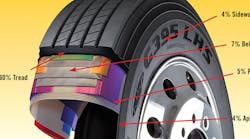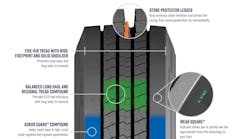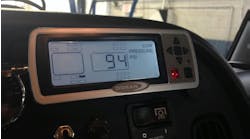Editor’s note: This is the third part of a series looking at how fleets are achieving higher MPG on U.S. roads. Read Part 1 and Part 2.
Even with the latest truck models and aerodynamic devices, overlooking tires as part of the overall fuel economy puzzle can be a costly mistake. Underinflation of just 10 psi reduces fuel economy by 1%, and improper inflation increases tire-related costs by $600-$800 per truck annually, according to the Technology & Maintenance Council.
Fuel economy gains from tires can be obtained from the tread of the tire, from the tread compound, tread design and tread depth. However, as each tire travels down the road, it creates a drag force, known as rolling resistance. The drive and trailer tires account for over 85% of total rolling resistance, according to Goodyear, so much of the focus is on those axle positions.
Fuel-efficient drive tires have 20% lower rolling resistance and can deliver up to a 3.5% improvement in fuel economy when all the tires are new. These gains shrink as the drive tires get closer to needing replacement.
Tire makers serving the trucking industry continue to develop options that extend life and boost fuel efficiency.
As a way to showcase the performance of truck tires, the neutral research organization PIT Group conducted special testing late last year. The Energotest included separate comparison tests on certain steer, drive, and trailer tires run on three identically spec’d tractors and trailers. The results showed fuel economy gains of up to 6% when comparing various tires.
Among the three tire makers that participated in the PIT Group test, Continental placed first, Double Coin was second, and Michelin was third.
After the results were announced, Continental pointed out that based on national average miles per gallon, miles traveled, and fuel cost from the North American Council on Freight Efficiency (NACFE), fleets could save about $13,000 per truck by switching to its tires.
Continental also stressed that fleets can improve fuel economy simply by maintaining correct tire pressure.
Double Coin said in a statement it was pleased with the results and added that when backed by multi-year warranties, “our customers can be confident in quality tires that deliver an ongoing lower cost per mile throughout the life of the tire.”
Separately, Michelin announced its X Line Energy D+ tire will be the featured longhaul drive tire on the new Freightliner Cascadia, contributing to the 5% fuel-efficiency improvement over the 2017 model.
“Selecting the right tire can play an important role in the fuel efficiency of Class 8 trucks,” said Kary Schaefer, general manager of marketing and strategy at Daimler Trucks North America.
During March, the company also launched the Michelin Energy Guard aerodynamic kit for trailers that provides 10 gallons in fuel savings every 1,000 miles. It consists of a trailer skirt, trailer-end fairings, aerodynamic mud flaps, and a wake reducer.
Elsewhere, Bridgestone Americas Inc. in April launched the all-new R284 Ecopia tire, a SmartWay-verified steer tire designed for improved fuel economy and enhanced treadwear. The company said it features an innovative tread compound for long wear life and NanoPro-Tech polymer technology for a 5% improvement in rolling resistance compared to the Ecopia R283A steer tire.
Likewise, Cooper Tire earlier this year launched a new longhaul steer tire as part of its PRO Series product line. The company designed it from the ground up, and it includes ECO (energy conservation optimization) technology. It is an ultra-low rolling resistance tire that both exceeds SmartWay standard requirements and meets 2021 greenhouse gas emissions requirements. The tire provides 18/32nds of tread depth and features a wider footprint than most other steer tires.
“This provides better traction while promoting longer, more even wear,” said Gary Schroeder, executive director of Cooper’s global truck and bus tire business. “And it doesn’t sacrifice fuel economy in the process. When paired with our PRO Series LHD drive tire, fleets can maximize fuel economy.”
Hankook Tire America, BFGoodrich, Toyo Tires and Yokohama Tire are among the other tire manufacturers that have rolled out new or upgraded products aimed at boosting fuel efficiency at a variety of price points.
This is the third part of a series looking at how fleets are achieving higher MPG on U.S. roads. Read Part 1 and Part 2.



